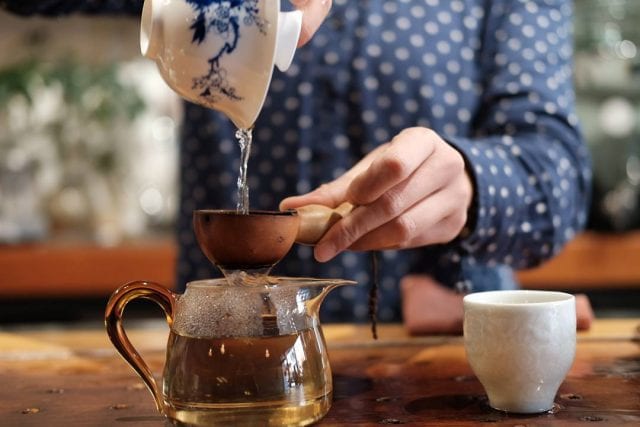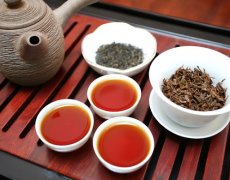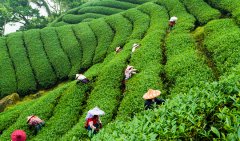The six types of tea are the most suitable for brewing tea. The temperature of tasting tea is better.
The brewing temperature refers to the temperature of the water used to make tea. Brewing temperature and time, tea dosage, water quality and brewing container are one of the key factors for brewing tea.
Many websites, tea companies and other sources recommend simple, uniform guidelines for brewing temperature. These guidelines usually boil down to black tea using boiling water (212 °F or 100 °C), while green tea uses cold water well below the boiling point (usually 160-180 °F or 71-82 °C). Some sources suggest that oolong tea and fine black tea (such as Darjeeling early spring tea) use medium temperature, usually white tea and green tea are mixed, and a lower brewing temperature is recommended. However, experienced tea drinkers often find that the ideal brewing temperature is much more complex.
This page goes deeper on the brewing temperature to help you get rid of cans or uniformly recommend steeper teas at what temperature, so you can find your own way to brew every tea you want.
Our suggestion is only as a starting point, most teas use near boiling water, but green tea, especially Japanese green tea, as well as Darjeeling white tea and oolong tea use lower temperature water. We did not find any evidence that most white teas are brewed in lower temperature water.
Tea is more or less sensitive to temperature.
Some teas are very sensitive to brewing temperature, and small changes in temperature can lead to great differences in the results of brewed teas. This type of tea is generally considered to be fickle or too picky about brewing temperature, or simply sensitive to brewing temperature.
In extreme cases, if soaked in too hot water, the tea will become smelly or undrinkable. Usually, when the temperature of the water is lower than the ideal temperature, the cup becomes milder. As for other teas, brewing temperature is less important; this type of tea is often described as easy to brew or can adapt to changes in brewing temperature.

The brewing temperature varies from person to person.
The brewing temperature, like most aspects of brewing tea, is largely a matter of personal taste. Although some teas are either insipid or unpleasant to most people, the situation of many teas is not so clear. Some aromas, tastes and other qualities of a kind of tea will be loved or appreciated by one person, but not by another person.
This is especially true for bitterness and astringency, which sometimes make some people happy, but if there are too many, almost everyone doesn't like it. The same is true of some aromas. The higher the brewing temperature, the stronger the taste of the tea. If you don't like the added taste, it may improve some people's feelings about tea, but it will damage others' feelings about tea.
The temperature of hot water during multiple brewing
When brewing tea that requires a lower brewing temperature, such as green tea, there are generally two ways to do it: keep the brewing temperature the same, or increase the temperature slightly each time. Tea drinkers usually raise the temperature or keep it the same (rather than lowering the temperature) each time they make tea, because this can extract the extra flavor. However, if you find that the temperature of a soak is too high, you may want to lower it for subsequent soaking.
Important Notice :
前街咖啡 FrontStreet Coffee has moved to new addredd:
FrontStreet Coffee Address: 315,Donghua East Road,GuangZhou
Tel:020 38364473
- Prev

Can pregnant women drink tea? What kind of tea would you like? What kind of scented tea can you drink the ten kinds of tea that pregnant women can't drink?
Is it safe to drink tea during pregnancy? From avid tea drinkers to occasional tea drinkers, many women find themselves asking whether it is safe to drink tea during pregnancy because of the caffeine content in the tea. In short, the answer is yes, but in moderation. This article discusses what research has been done on this topic and what organizations of medical professionals have proposed on this topic.
- Next

The top ten famous teas in Taiwan introduce which varieties of Taiwan tea are planted and which are good to drink in the region.
Taiwan, commonly known as Formosa in the tea industry, is an important producer of tea, especially oolong tea. The output of tea in Taiwan is not high, but Taiwan's tea is very representative in characteristic teahouses and is also famous among tea connoisseurs. Most of the tea produced in Taiwan is consumed in Taiwan. Taiwan has a strong tea culture and has high requirements for Taiwan's tea market.
Related
- Being chased out of the rain in front of Starbucks?! Store: Sheltering from rain under umbrellas poses a safety hazard
- The white moonlight has changed?! Lucky launches "Big Winter Pear American"
- Hand-brewed coffee three-stage method, high-sweet and universal brewing method to share! What does the high sweet water level of hand-brewed coffee mean?
- What is the difference between raw, refined and full espresso coffee? How to extract espresso and taste good?
- A complete list of coffee bean names and their meanings! What is Yejia Shefi coffee? Where is Mantelin coffee?
- What grade does Arida Manor Kaduai coffee beans belong to? What treatment is Arida ASD slow anaerobic sun exposure?
- The milk tea cup becomes smaller?! Overlord Tea Girl launches a new "Return to Yunnan" series
- Accused of selling counterfeit and high-priced coffee beans! Well-known boutique coffee brand "Oukelao" bowed and apologized!
- How to make espresso dumplings? Can I eat coffee and glutinous rice balls together?
- Save the unformed and stagnant powder cakes in one second! What is the problem with stagnant water in the powder bowl of the espresso machine?

